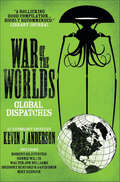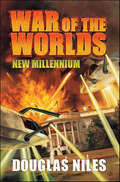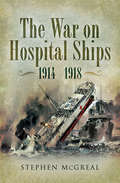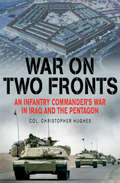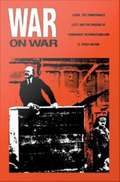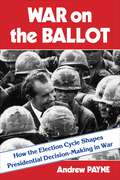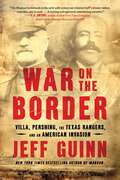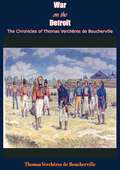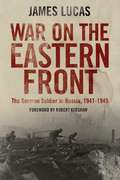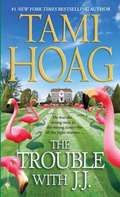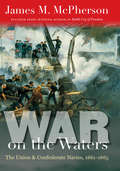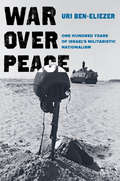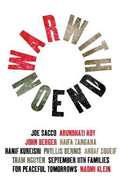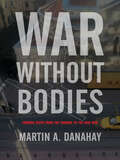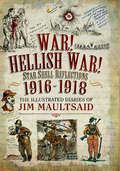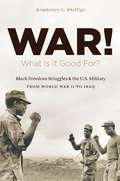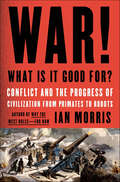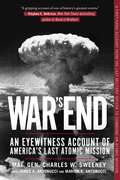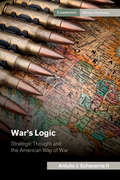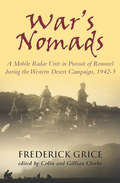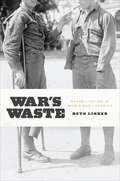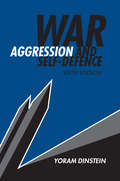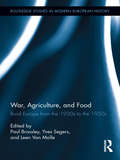- Table View
- List View
War of the Worlds: Global Dispatches
by H. G. WellsFrom the father of science fiction, the nineteenth-century British classic novel of alien invasion, along with two sequels. Together in one volume for the first time—H. G. Wells&’s seminal science fiction classic The War of the Worlds, with the contemporaneous, unauthorized, but extremely popular sequel Edison&’'s Conquest of Mars, as well as Wells&’s own, much later conceptual sequel, Star Begotten. How often do you watch the sky at night? Ever see bright streaks of light exploding from the red planet? Get ready for adventurous reading as you embark on a journey to find out just how these alien invasions play out! In The War of the Worlds, how will woefully unprepared Earthlings respond to towering three-legged &“fighting machines&” armed with heat-rays and chemical weapons that far exceed the capabilities of the nineteenth-century English military? In Edison&’s Conquest of Mars, Earth's leaders fear that the Martians will return to invade once more. US President William McKinley, Queen Victoria, Kaiser Wilhelm II and Emperor Mutsuhito unite to plan an attack on Mars. Led by American inventor Thomas Edison, a group of scientists develop new technologies based on what earlier Martian visitors left behind. They design and build a fleet of space ships for the pre-emptive move. What will happen when the two opposing forces meet? The protagonist of Star Begotten, Joseph Davis, is an author of popular histories, who becomes suspicious that he and his family have been exposed to a Martian influence of another sort and are in the process of being changed. What might that influence be? Three classics of Martian invasion in one volume.
War of the Worlds: New Millennium
by Douglas NilesFirst the Mars probe picked up an anomaly.Then NASA saw some strange activity, and many stargazers noticed meteorites rocketing towards earth.A cylinder surreptitiously landed in Wisconsin, then another, and another...and then invasion from Mars.The War of the Worlds had begun.War of the Worlds: New Millennium follows in the great tradition of Wells' original masterpiece, Niven and Pournelle's Footfall, and 'V' the mini-series. It is the story of an alien invasion of earth as told from numerous viewpoints:- a writer in rural Wisconsin- a soldier in the field- a science advisor to the presidentAs tripods leave a swath of destruction across the Americas, Washington groups some of its great minds to solve the problem as the Pentagon throws at the invaders the latest hardware the military has to offer.At stake is the survival of the human race and the dominion of planet earth.Filled with techno-thriller like detail, War of the Worlds: New Millennium merges Clancy with Clarke for a truly page turning science fiction thriller.At the Publisher's request, this title is being sold without Digital Rights Management Software (DRM) applied.
War on Hospital Ships, 1914–1918
by Stephen McGrealIt is often said The first casualty of war is the truth and there is no better example of this than the furore caused by the claims and counterclaims of the British and German Governments at the height of the First World War. Wounded allied personnel were invariably repatriated by hospital ships, which ran the gauntlet of mined waters and gambled on the humanity of the U- Boat commanders. For, contrary to the terms of the Geneva Convention, on occasions Germany had sunk the unarmed hospital ships under the pretense they carried reinforcement troops and ammunition. The press seized on these examples of Hun Barbarity, especially the drowning of noncombatant female nurses. The crisis heightened following the German Governments 1 February 1917 introduction of unrestricted naval warfare. The white painted allied hospital ships emblazoned with huge red crosses now became in German eyes legitimate targets for the U-Boats. As the war on the almost 100 strong fleet of hospital ships intensified the British threatened reprisals against Germany, in particular an Anglo-French bombing raid upon a German town. Undeterred the Germans stepped up their campaign sinking two hospital ships in swift succession. Seven hospital ships struck mines and a further eight were torpedoed. Faced with such a massacre of the innocents Britain decided her hospital ships, painted and brightly lit in accordance with the Geneva Convention, could no longer rely on this immunity. The vessels were repainted in drab colors, defensively armed and sailed as ambulance transports among protected convoys. Germany had successfully banished hospital ships from the high seas.
War on Two Fronts: An Infantry Commander's War in Iraq and the Pentagon
by Col. Christopher HughesA vivid memoir of the conflict&’s early years combined with &“an insightful review of our problems in Iraq&” (Publishers Weekly). Winner of The Army Historical Foundation&’s Distinguished Writing Award. Shortly after the launch of Operation Iraqi Freedom, the war in Iraq became the most confusing in US history, the high command not knowing who to fight, who was attacking coalition troops, and who among the different Iraqi groups were fighting each other. Yet there were a few astute officers like Lt. Col. Christopher Hughes, commanding the 2nd Battalion of the 327th Infantry Regiment, 101st Airborne, who sensed the complexity of the task from the beginning. In War on Two Fronts, Lt. Col. Hughes writes movingly of his &“no-slack&” battalion at war in Iraq. The war got off to a bang for Hughes when his brigade command tent was fragged, leaving him briefly in charge of the brigade. Amid the nighttime confusion of fourteen casualties, a nearby Patriot missile blasted off, panicking nearly everyone while mistakenly bringing down a British Tornado fighter-bomber. As Hughes&’ battalion forged into Iraq, they successfully liberated the city of Najaf, securing the safety of Grand Ayatollah Sistani and the Mosque of Ali while showing an acute cultural awareness that caught the world&’s attention. It was a feat that landed Hughes within the pages of Time, Newsweek, and other publications. The Screaming Eagles of the 101st Airborne then implemented creative programs in the initial postwar occupation, including harvesting the national wheat and barley crops while combating nearly invisible insurgents. Conscious that an army battalion is a community of some seven-hundred-plus households, and that when a unit goes off to war, the families are intimately connected in our internet age, Hughes makes clear the strength of those connections and how morale is best supported at both ends. Transferred to Washington after his tour, Hughes also writes an illuminating account of the herculean efforts of many in the Pentagon to work around the corporatist elements of its bureaucracy in order to better understand counterinsurgency and national reconstruction, which Lawrence of Arabia described as &“like learning to eat soup with a knife.&” This book helps explain the sources of mistakes made—and the process needed to chart a successful strategy. Written with candor and no shortage of humor, mixed with brutal scenes of combat and frank analysis, it is a must-read for all who seek insight into our current situation in the Mideast.
War on War: Lenin, the Zimmerwald Left, and the Origins of Communist Internationalism
by R. Craig NationThe outbreak of World War I precipitated a schism in the international socialist movement that endures today. Heeding calls for “rational defense,” the leading European socialist democratic parties abandoned their vision of peace and internationalism as an integral part of the struggle for social justice and set aside their view of interstate war as the clearest example of the irrational essence of competitive capitalism. Only the Zimmerwald Left, led by Lenin, continued to speak out for internationalism. R. Craig Nation utilizes sources in Dutch, French, German, Italian, Russian, and Swedish to provide the first comprehensive history of the Zimmerwald Left as an international political tendency.
War on the Ballot: How the Election Cycle Shapes Presidential Decision-Making in War
by Andrew PayneThe president of the United States is at once holder of the highest elected office and commander in chief of the armed forces. How do upcoming elections influence presidents’ behavior during wartime? How do presidents balance perceptions of the national interest with personal political interests?War on the Ballot examines how electoral politics shaped presidential decisions on military and diplomatic strategy during the wars in Korea, Vietnam, and Iraq. Drawing on a wealth of declassified documents and interviews with senior officials and military officers, Andrew Payne reveals the surprisingly large role played by political considerations during conflicts. He demonstrates how the exigencies of the electoral cycle drove leaders to miss opportunities to limit the human and financial costs of each war, gain strategic advantage, or sue for peace, sometimes making critical decisions with striking disregard for the consequences on the ground. Payne emphasizes the importance of electoral pressures throughout the full course of a conflict, not just around the initial decision to intervene. He shows how electoral constraints operate across different phases of the political calendar, going beyond the period immediately preceding a presidential election.Offering a systematic analysis of the relationship between electoral politics and wartime decision-making, this book raises crucial questions about democratic accountability in foreign policy.
War on the Border: Villa, Pershing, the Texas Rangers, and an American Invasion
by Jeff GuinnAn &“engagingly written&” (The Wall Street Journal) account of the &“Punitive Expedition&” of 1916 that brought Pancho Villa and Gen. John J. Pershing into conflict, and whose reverberations continue in the Southwestern US to this day.Jeff Guinn, chronicler of the Southwestern US and of American undesirables (Bonnie and Clyde, Charles Manson, and Jim Jones) tells the &“riveting and supremely entertaining narrative&” (S.C. Gwynne, New York Times bestselling author of Empire of the Summer Moon) of Pancho Villa&’s bloody raid on a small US border town that sparked a violent conflict with the US. The &“Punitive Expedition&” was launched in retaliation under Pershing&’s command and brought together the Army, National Guard, and the Texas Rangers—who were little more than organized vigilantes with a profound dislike of Mexicans on both sides of the border. Opposing this motley military brigade was Villa, a guerrilla fighter who commanded an ever-changing force of conscripts in northern Mexico. The American expedition was the last action by the legendary African American &“Buffalo Soldiers.&” It was also the first time the Army used automobiles and trucks, which were of limited value in Mexico, a country with no paved roads or gas stations. Curtiss Jenny airplanes did reconnaissance, another first. One era of warfare was coming to a close as another was beginning. But despite some bloody encounters, the Punitive Expedition eventually withdrew without capturing Villa. Today Anglos and Latinos in Columbus, New Mexico, where Villa&’s raid took place, commemorate those events, but with differing emotions. And although the bloodshed has ended, the US-Mexico border remains as vexed and volatile an issue as ever.
War on the Detroit: The Chronicles of Thomas Verchères de Boucherville
by Thomas Verchères de BouchervilleAn inside look at the War of 1812 from the journals of two young men, edited by American historian Milo Milton Quaife (1880-1959). Part I of the book is the journal of Thomas Vercheres de Boucheville, of French descent; and part II is from someone who called himself "an Ohio volunteer". Both are drawn into the war by circumstances, and converge on the battle for Detroit (it was little more than a village then). A fascinating look at a young nation at war on the frontier wilderness.
War on the Eastern Front: The German Soldier in Russia, 1941–1945 (Greenhill Military Paperback Ser.)
by James LucasThis classic WWII history presents a comprehensive yet vividly detailed account of the Third Reich&’s epic and bitter clash with the Red Army. The opening onslaughts of Operation Barbarossa began on June 22nd, 1941, as German forces stormed into the Soviet Union. Few of them were to survive the five long years of bitter struggle. A posting to the Eastern Front during the Second World War was rightly regarded with dread by the German soldiers. They faced the unremitting hostility of the climate, the people and even, at times, their own leadership. There were epic conflicts, such as the battles of Stalingrad and Kursk. But surrounding these famous events was a daily war of attrition which ultimately ground Hitler&’s war machine to a halt. In this classic account, military historian James Lucas examines the Eastern Front from trench warfare to a bicycle-mounted antitank unit fighting against the oncoming Russian hordes. Told through the experiences of the German soldiers who endured these nightmarish years of warfare, War on the Eastern Front is a unique record of this cataclysmic campaign.
War on the Run: The Epic Story of Robert Rogers and the Conquest of America’a First Frontier
by John F. RossRoss, executive editor of American Heritage magazine, has written this biography of American colonial frontiersman Robert Rogers to reveal how his observations of Native American warriors led to combat strategies that are still effective today. Written for general audiences, this book explains how Rogers trained and led an army of farmers, scouts and woodsmen on a series of military missions that are still considered impossible today. The author also explains how Rogers' 28 Rules of Engagement laid the groundwork for the Revolutionary War, and how his explorations of the frontier inspired the Lewis and Clark expedition. Annotation ©2009 Book News, Inc., Portland, OR (booknews.com)
War on the Waters
by James M. McphersonAlthough previously undervalued for their strategic impact because they represented only a small percentage of total forces, the Union and Confederate navies were crucial to the outcome of the Civil War. In War on the Waters, James M. McPherson has crafted an enlightening, at times harrowing, and ultimately thrilling account of the war's naval campaigns and their military leaders. McPherson recounts how the Union navy's blockade of the Confederate coast, leaky as a sieve in the war's early months, became increasingly effective as it choked off vital imports and exports. Meanwhile, the Confederate navy, dwarfed by its giant adversary, demonstrated daring and military innovation. Commerce raiders sank Union ships and drove the American merchant marine from the high seas. Southern ironclads sent several Union warships to the bottom, naval mines sank many more, and the Confederates deployed the world's first submarine to sink an enemy vessel. But in the end, it was the Union navy that won some of the war's most important strategic victories--as an essential partner to the army on the ground at Fort Donelson, Vicksburg, Port Hudson, Mobile Bay, and Fort Fisher, and all by itself at Port Royal, Fort Henry, New Orleans, and Memphis.
War over Peace: One Hundred Years of Israel's Militaristic Nationalism
by Uri Ben-EliezerViolence and war have raged between Zionists and Palestinians for over a century, ever since Zionists, trying to establish a nation-state in Palestine, were forced to confront the fact that the country was already populated. Covering every conflict in Israel’s history, War over Peace reveals that Israeli nationalism was born ethnic and militaristic and has embraced these characteristics to this day. In his sweeping and original synthesis, Uri Ben-Eliezer shows that this militaristic nationalism systematically drives Israel to find military solutions for its national problems, based on the idea that the homeland is sacred and the territory is indivisible. When Israelis opposed to this ideology brought about change during a period that led to the Oslo Accords in the 1990s, cultural and political forces, reinforced by religious and messianic elements, prevented the implementation of the agreements, which brought violence back in the form of new wars. War over Peace is essential reading for anyone who wants to understand the role of ethnic nationalism and militarism in Israel as well as throughout the world.
War with China: Thinking Through the Unthinkable
by David C. Gompert Astrid Stuth Cevallos Cristina L. GarafolaIn the event of a Sino-U.S. war, intense conventional counterforce attacks could inflict heavy losses and costs on both sides, so leaders need options to contain and terminate fighting. As it takes steps to reduce the likelihood of war with China, the United States must prepare for one by reducing force vulnerabilities, increasing counter-anti-access and area-denial capabilities, and using economic and international effects to its advantage.
War with No End
by Arundhati Roy Naomi Klein John Berger Phyllis Bennis Haifa Zangana Hanif Kureishi Joe Sacco Ahdaf Soueif Tram NguyenOn October 7th 2001, US-led forces invaded Afghanistan, marking the start of George Bush and Tony Blair's "War on Terror." Six years on, where have the policies of Bush and Blair left us?
War without Bodies: Framing Death from the Crimean to the Iraq War (War Culture)
by Martin DanahayHistorically the bodies of civilians are the most damaged by the increasing mechanization and derealization of warfare, but this is not reflected in the representation of violence in popular media. In War Without Bodies, author Martin Danahay argues that the media in the United States in particular constructs a “war without bodies” in which neither the corpses of soldiers or civilians are shown. War Without Bodies traces the intertwining of new communications technologies and war from the Crimean War, when Roger Fenton took the first photographs of the British army and William Howard Russell used the telegraph to transmit his dispatches, to the first of three “video wars” in the Gulf region in 1990-91, within the context of a war culture that made the costs of organized violence acceptable to a wider public. New modes of communication have paradoxically not made more war “real” but made it more ubiquitous and at the same time unremarkable as bodies are erased from coverage. Media such as photography and instantaneous video initially seemed to promise more realism but were assimilated into existing conventions that implicitly justified war. These new representations of war were framed in a way that erased the human cost of violence and replaced it with images that defused opposition to warfare. Analyzing poetry, photographs, video and video games the book illustrates the ways in which war was framed in these different historical contexts. It examines the cultural assumptions that influenced the reception of images of war and discusses how death and damage to bodies was made acceptable to the public. War Without Bodies aims to heighten awareness of how acceptance of war is coded into texts and how active resistance to such hidden messages can help prevent future unnecessary wars.
War! Hellish War! Star Shell Reflections, 1916–1918: The Illustrated Diaries of Jim Maultsaid
by Barbara McCluneJim Maultsaid's illustrated diaries of his Great War service offer a unique and completely original perspective of a fighting mans experiences.Although an American citizen Jim was living in Donegal in 1914 and first joined the Young Citizens Volunteers and then the British Army. On 1 July 1916 the first day of the Somme, Sergeant Maultsaid was seriously wounded. To quote from his diary as he lay in no-mans-land The most awful cries rent the night air it was a shambles it was Hell with the lid off it was. Unlike so many, Jim survived and was hospitalised in Blighty. After a spell in Northern Ireland, he was selected for officer training at Cambridge. He was commissioned into The Chinese Labour Corps and his words and art work throw fascinating light on this little known but invaluable organization. Jims admiration for the CLCs contribution and culture is obvious.War! Hellish War! is more than a Great War diary it is a masterpiece and a collectors item of great historical and educational value. Despite the countless records of this conflict there is nothing to compare it with.
War! What Is It Good For?
by Kimberley L. Phillips BoehmAfrican Americans' long campaign for "the right to fight" forced Harry Truman to issue his 1948 executive order calling for equality of treatment and opportunity in the armed forces. In War! What Is It Good For?, Kimberley Phillips examines how blacks' participation in the nation's wars after Truman's order and their protracted struggles for equal citizenship galvanized a vibrant antiwar activism that reshaped their struggles for freedom. Using an array of sources--from newspapers and government documents to literature, music, and film--and tracing the period from World War II to the Iraq and Afghanistan wars, Phillips considers how federal policies that desegregated the military also maintained racial, gender, and economic inequalities. Since 1945, the nation's need for military labor, blacks' unequal access to employment, and discriminatory draft policies have forced black men into the military at disproportionate rates. While mainstream civil rights leaders considered the integration of the military to be a civil rights success, many black soldiers, veterans, and antiwar activists perceived war as inimical to their struggles for economic and racial justice and sought to reshape the civil rights movement into an antiwar black freedom movement. Since the Vietnam War, Phillips argues, many African Americans have questioned linking militarism and war to their concepts of citizenship, equality, and freedom.
War! What Is It Good For?: Conflict and the Progress of Civilization from Primates to Robots
by Ian MorrisA powerful and provocative exploration of how war has changed our society—for the better.“War!. . . . / What is it good for? / Absolutely nothing,” says the famous song—but archaeology, history, and biology show that war in fact has been good for something. Surprising as it sounds, war has made humanity safer and richer.In War! What Is It Good For?, the renowned historian and archaeologist Ian Morris tells the gruesome, gripping story of fifteen thousand years of war, going beyond the battles and brutality to reveal what war has really done to and for the world. Stone Age people lived in small, feuding societies and stood a one-in-ten or even one-in-five chance of dying violently. In the twentieth century, by contrast—despite two world wars, Hiroshima, and the Holocaust—fewer than one person in a hundred died violently. The explanation: War, and war alone, has created bigger, more complex societies, ruled by governments that have stamped out internal violence. Strangely enough, killing has made the world safer, and the safety it has produced has allowed people to make the world richer too.War has been history’s greatest paradox, but this searching study of fifteen thousand years of violence suggests that the next half century is going to be the most dangerous of all time. If we can survive it, the age-old dream of ending war may yet come to pass. But, Morris argues, only if we understand what war has been good for can we know where it will take us next.Praise for War! What Is It Good For?“[Morris’s] pace is perfect, his range dazzling, his phrasemaking fluent, his humor raucous. . . . [A] rattling good book.” —Felipe Fernández-Armesto, The Wall Street Journal“Ian Morris’s evidence that war has benefited our species—albeit inadvertently—is provocative, compelling, and fearless. This book is equally horrific and inspiring, detailed and sweeping, lighthearted and dead serious. For those who think war has been a universal disaster, it will change the way they think about the course of history.” —Richard Wrangham, coauthor of Demonic Males and author of Catching Fire“A disturbing, transformative text that veers toward essential reading.” —Kirkus Reviews (starred review)
War's End: An Eyewitness Account of America's Last Atomic Mission
by Charles W. Sweeney James A. Antonucci Marion K. AntonucciOn August 9, 1945, on the tiny island of Tinian in the South Pacific, a twenty-five-year-old American Army Air Corps major named Charles W. Sweeney climbed aboard a B-29 Superfortress in command of his first combat mission, one devised specifically to bring a long and terrible war to a necessary conclusion. In the belly of his bomber, Bock's Car, was a newly developed, fully armed weapon that had never been tested in a combat situation. It was a weapon capable of a level of destruction never before dreamed of in the history of the human race, a bomb whose terrifying aftershock would ultimately determine the direction of the twentieth century and change the world forever. The last military officer to command an atomic mission, Major General Charles W. Sweeney has the unique distinction of having been an integral part of both the Hiroshima and the Nagasaki bombing runs. Now updated with a new epilogue from the co-author, his book is an extraordinary chronicle of the months of careful planning and training; the setbacks, secrecy, and snafus; and the nerve-shattering final seconds and the astonishing aftermath of what is arguably the most significant single event in modern history: the employment of an atomic weapon during wartime. The last military officer to command an atomic mission, Major General Charles W. Sweeney has the unique distinction of having been an integral part of both the Hiroshima and the Nagasaki bombing runs. His book is an extraordinary chronicle of the months of careful planning and training; the setbacks, secrecy, and snafus; and the nerve-shattering final seconds and the astonishing aftermath of what is arguably the most significant single event in modern history: the employment of an atomic weapon during wartime.
War's Logic: Strategic Thought and the American Way of War (Cambridge Military Histories)
by Antulio J. Echevarria IIAntulio J. Echevarria II reveals how successive generations of American strategic theorists have thought about war. Analyzing the work of Alfred Thayer Mahan, Billy Mitchell, Bernard Brodie, Robert Osgood, Thomas Schelling, Herman Kahn, Henry Eccles, Joseph Wiley, Harry Summers, John Boyd, William Lind, and John Warden, he uncovers the logic that underpinned each theorist's critical concepts, core principles, and basic assumptions about the nature and character of war. In so doing, he identifies four paradigms of war's nature - traditional, modern, political, and materialist - that have shaped American strategic thought. If war's logic is political, as Carl von Clausewitz said, then so too is thinking about war.
War's Nomads: A Mobile Radar Unit in Pursuit of Rommel during the Western Desert Campaign, 1942–3
by Frederick Grice&“The only known detailed account in existence of the small radar units who played a key part in the Western Desert Campaign . . . Highly recommended&” (Military Modelcraft International). War&’s Nomads is an evocative account of one man&’s experience of life in a mobile radar unit after the battle of El Alamein as Rommel&’s Afrika Korps was relentlessly pursued across the desert through Egypt, Libya, and Tunisia by the Eighth Army. After Fred Grice was called up in 1941, he kept two journals of his experiences. The first deals with waiting to embark after initial training, the journey to the battle zone, and the privations of a low-ranking AC. Daily life onboard a ship is vividly brought to life with details of routine, the cramped conditions, the banter and hobbies used to pass the time by the troops, and the luxurious-by-contrast existence of the officers. The second gives a detailed account of the activities of Unit 606, a radar crew that follows just behind the battlefront. 606 provided radio-detection for the advanced landing grounds being used by RAF fighter-bomber squadrons, because these landing strips, in turn, were the target of the German Luftwaffe and Italian Air Force attacks. It was a tiny unit, never more than ten men, frequently operating for protracted periods in complete isolation. Fred Grice&’s account lyrically evokes the landscape and the often tense and dangerous environment they operated in, pitching the reader into the experience of traveling with the unit in a three-ton truck, finding ingenious solutions to lack of rations and living space, even commandeering an abandoned boat to relax in the sea, while constantly needing to be alert to dodge air attacks. Along with these colorful first-person accounts, War&’s Nomads includes an authoritative introduction explaining the background to the military events of the Western Desert campaign, and the purpose of 606&’s mission, which Grice for security reasons could not talk about: to get to a selection of the two hundred or so landing grounds in the desert with all speed—and then defend them against air attack by using a light warning radar set developed to go operational within an hour.
War's Waste: Rehabilitation in World War I America
by Beth LinkerWith US soldiers stationed around the world and engaged in multiple conflicts, Americans will be forced for the foreseeable future to come to terms with those permanently disabled in battle. At the moment, we accept rehabilitation as the proper social and cultural response to the wounded, swiftly returning injured combatants to their civilian lives. But this was not always the case, as Beth Linker reveals in her provocative new book, War's Waste. Linker explains how, before entering World War I, the United States sought a way to avoid the enormous cost of providing injured soldiers with pensions, which it had done since the Revolutionary War. Emboldened by their faith in the new social and medical sciences, reformers pushed rehabilitation as a means to "rebuild" disabled soldiers, relieving the nation of a monetary burden and easing the decision to enter the Great War. Linker's narrative moves from the professional development of orthopedic surgeons and physical therapists to the curative workshops, or hospital spaces where disabled soldiers learned how to repair automobiles as well as their own artificial limbs. The story culminates in the postwar establishment of the Veterans Administration, one of the greatest legacies to come out of the First World War.
War's Waste: Rehabilitation in World War I America
by Beth LinkerWith US soldiers stationed around the world and engaged in multiple conflicts, Americans will be forced for the foreseeable future to come to terms with those permanently disabled in battle. At the moment, we accept rehabilitation as the proper social and cultural response to the wounded, swiftly returning injured combatants to their civilian lives. But this was not always the case, as Beth Linker reveals in her provocative new book, War’s Waste. Linker explains how, before entering World War I, the United States sought a way to avoid the enormous cost of providing injured soldiers with pensions, which it had done since the Revolutionary War. Emboldened by their faith in the new social and medical sciences, reformers pushed rehabilitation as a means to “rebuild” disabled soldiers, relieving the nation of a monetary burden and easing the decision to enter the Great War. Linker’s narrative moves from the professional development of orthopedic surgeons and physical therapists to the curative workshops, or hospital spaces where disabled soldiers learned how to repair automobiles as well as their own artificial limbs. The story culminates in the postwar establishment of the Veterans Administration, one of the greatest legacies to come out of the First World War.
War, Aggression and Self-Defence
by Yoram DinsteinYoram Dinstein's seminal textbook is an essential guide to the legal issues of war and peace, armed attack, self-defence and enforcement measures taken under the aegis of the Security Council. This third edition incorporates new material on the Kosovo air campaign, 'humanitarian intervention', recent resolutions adopted by the Security Council, the latest pronouncements of the International Court of Justice and the International Criminal Tribunal for the former Yugoslavia. Also discussed are new treaties including the 1998 Rome Statute on the International Criminal Court and current studies of the International Law Commission. In addition, supplementary sections consider, for example, enforcement action carried out by regional organizations under the authority of the Security Council. War, Aggression and Self-Defence remains a comprehensive and highly readable introduction to the legal issues surrounding war and self-defence, and continues to provide an indispensable tool for students and practitioners of international law, international relations and military studies.
War, Agriculture, and Food: Rural Europe from the 1930s to the 1950s (Routledge Studies in Modern European History)
by Paul Brassley Yves Segers Leen Van MolleBetween the 1930s and the 1950s rural life in Europe underwent profound changes, partly as a result of the Second World War, and partly as a result of changes which had been in progress over many years. This book examines a range of European countries, from Scandinavia to Spain and Ireland to Hungary, during this crucial period, and identifies the common pressures to which they all responded and the features that were unique to individual countries. In particular, it examines the processes of agricultural development over western Europe as a whole, the impact of the war on international trading patterns, the relationships between states and farmers, and the changing identities of rural populations. It presents a bold attempt to write rural history on a European scale, and will be of interest not only to historians and historical geographers, but also to those interested in the historical background to the Common Agricultural Policy of the European Union, to which the changes discussed here provided a dramatic prologue.
